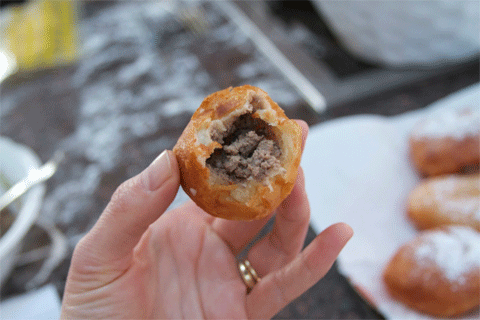
LIGHTER THAN AIR Beef and onions hide inside "the softest fried dough I've ever tasted." |
Just in time for Olympic gatherings, Russian grandmother Alla Zagoruyko has taught me how to make her favorite party food from home. It’s fried dough in the shape of a hot dog bun with ground beef and onions sealed inside.
“Don’t call it a beef donut,” her daughter, Yulia Converse, says. “That will confuse people” because it’s not sweet. In Russian the name for this food is pirogi, but because my Polish-American relatives use a very similar word for a completely different food (a boiled dumpling), I’m calling them Russian beef buns.
They are the softest fried dough I’ve ever tasted. When you bite into one, it’s like your jaws are on a slow-motion trampoline, your taste buds miraculously flying through air and umami flavor at the same time. I had to know: How does Alla get her fried dough to come out so divinely light? The short answer is yeast. The long answer is that she does a lot of little things to infuse the buns with air — and to keep that air locked in. It’s hard to know which tricks are based on superstition and which, physics.
When she sifts the flour, she holds the sifter 12 inches above the bowl, which allows the flour to catch air as it floats down into a snowy peak. Then she mixes in flour, warm milk, yeast, melted butter, salt, and sugar, which whirl in a stand mixer for a good 25 minutes, physically incorporating air into the dough. The slim ratio of dry to wet ingredients is also key to keeping the density down. At first the ingredients in the mixing bowl looked as wet as cake batter. I honestly didn’t believe they would eventually mix into dough, but sure enough, after almost half an hour the ingredients miraculously pulled cleanly away from the sides of the mixing bowl.
She is particular about the atmospheric conditions in the house. “The dough doesn’t like noise,” Yulia explains matter-of-factly.
After covering the bowl of dough with clean dishtowels, Alla wraps the bowl in a wool blanket and buries it under pillows in a couch in her bedroom. Yulia remembers that when she was a kid, her mom would say to her and her brother: “Well, I made the dough. You guys don’t make too much noise.” Yulia specifies the rules: There can be “nobody running, slamming doors, no yelling at each other,” for two hours while the dough rises.
Later, when Alla tips the bowl sideways on the floured countertop, the dough rolls out as an amorphous and still-moving mound, not quite a solid, not quite a liquid. Alla kisses the air above the dough and says quietly in Russian, “with love and respect.” Then she cuts pieces off the mound with a paring knife and forms disks of dough using her hands and a quick turn of the rolling pin. She spoons sautéed ground beef and onions onto each disk, pinches them closed, and places batches of buns gently into a pan of hot oil where they puff up and turn golden. (She also fries some dough with no filling and sprinkles those with powdered sugar.)